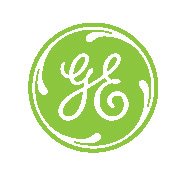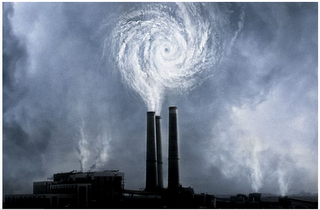Tuesday, May 23, 2006
Go ahead, emit!
Wow, this is seriously weird. Some organisation called "Competetive enterprise Institute" (sponsored by Exxon-mobil among others) has produced two very slick TV-ads that promote CO2. We call it life, they say. Check 'em out, you need to see this.
Monday, May 22, 2006
GE Ecomagination publishes first annual report

GE has just published a report/36 page advertising that describes the first year of their Ecomagination initiativ. It’s not perfect, some may think it’s mostly greenwash, but I happen to be impressed. It’s a very big company and taking it through this kind of re-orientation can not be easy. It’s an audacious undertaking, and it has real impact. Respect!
From the report:
Specifically, GE has pledged to:
Double its investment in clean R&D—GE is growing
its research in cleaner technologies from $700 million
in 2005 to $1.5 billion in 2010.
Increase revenues from ecomagination products—
GE will grow revenues from products and services that
provide significant and measurable environmental performance
advantages to customers—to at least $20 billion
in 2010, with more aggressive targets thereafter.
Reduce its greenhouse gas (GHG) emissions and improve
the energy efficiency of its operations—GE is committed to
reduce its GHG emissions 1% by 2012, reduce the intensity
of its GHG emissions 30% by 2008, and improve energy
efficiency 30% by the end of 2012 (all compared to 2004.)
Without this action, GHG emissions were predicted to rise
substantially by 2012, based on GE’s projected growth.
Keep the public informed—This report is just one way GE
will publicly report its progress in meeting these goals.
What’s so inconvenient about climate change?
Attempting to reduce climate change demands us to change our lifestyle at a very basic level. In one sense it represents a reversal of a development that has been a main characteristic of humanity.
The story of human development is intimately linked to our increasing power and freedom to connect and move around over ever larger distances.
With the technology that is likely to be available in the foreseeable future, avoiding climate change by reducing CO2 emissions, will require us to reverse that. So: Less jetting and driving around, less long distance trade, less freedom to choose whatever we want anywhere and anytime.
There are a lot of very good reasons to wish that we can continue towards higher connectivity, a cosmopolitan society, more comfort. It’s a big part of desires of modern man and woman: this slick world where humans get what we want - now.
Giving it up is not only inconvenient - somehow it feels like crawling backwards in the evolutionary tree.
The story of human development is intimately linked to our increasing power and freedom to connect and move around over ever larger distances.
With the technology that is likely to be available in the foreseeable future, avoiding climate change by reducing CO2 emissions, will require us to reverse that. So: Less jetting and driving around, less long distance trade, less freedom to choose whatever we want anywhere and anytime.
There are a lot of very good reasons to wish that we can continue towards higher connectivity, a cosmopolitan society, more comfort. It’s a big part of desires of modern man and woman: this slick world where humans get what we want - now.
Giving it up is not only inconvenient - somehow it feels like crawling backwards in the evolutionary tree.
Saturday, May 20, 2006
SAS Airlines offers emission calculator

You can't really say you don't know. SAS has created a web-service so passengers can see the emissions that the flight they are booking will cause.
Great idea, although it's very well hidden if you are accessing their website from the frontpage. I only found it because I had been given the direct link.
Al Gore on global warming

The trailer for "The incovenient truth", a new film with Al Gore presenting the scary low-down on climate change is out, as well as an extensive website with scientific facts, a calculator to see just how much damage you're doing, and the inevitable blog.
Judging from the trailer, it looks like a very powerful piece of argumentation - the Hollywood drama and bombastic music is not quite to my liking, but I have a sense that this might be what it takes to really get the message out.
It's a terrible situation we're facing - but at last it looks like the issue will emerge from denial. Next step is some action, but, uh, that's the hard part. Very inconvenient, indeed.
Monday, May 15, 2006
Heatwave in dense environment
Saturday, May 13, 2006
What kind of package would you like for your milk?

The Danish organic dairy producer Thise Mælk is currently using their milk cartons to ask consumers whether they would like a screw top on the milk cartons in the future. Very nice touch. I have no doubt that it provides genuinely useful information for Thise - while at the same time I, as a consumer, get a sense that they actually care and try to produce in a way that I prefer.
You vote by going to their website, of course. I voted no.
Tuesday, May 02, 2006
Elements of the web 2.0-sphere
In his speech at Emerging tech 06 (blogged below) Bruce Sterling gives a good wrap up of some of the elements of the web 2.0-sphere (at about 34 minutes into the speech):
- Un-intended use
- user contribution
- effortless scaleability
- radical decentralization
- costumer self service
- mass service of micromarkets
- software as a service
- right to remix
- architected participation
- Un-intended use
- user contribution
- effortless scaleability
- radical decentralization
- costumer self service
- mass service of micromarkets
- software as a service
- right to remix
- architected participation
Spimes?
IT-conversation just posted a good speech by Bruce Sterling, recorded at Emerging Tech 2006. The title is ”The internet of things”. As usual Sterling is deeper than he appears to be.
In his speech Sterling outlines 6 qualities of a future ”internet of things”:
1. With interactive chips, objects can be labelled with unique identeties, electronically bar-coded, using RFID, a tag that you can mark, rank, sort and shuffle.
2. With local and precise positioning systems, geolocative systems which work out where you are and where things are.
3. With powerful search engines, autogoogling objects.
4. With cradle to cradle recycling, sustainability, transparent production, sorting and shuffling of garbage
5. 3d virtual models of things, virtual design, cad and cam, having objects present as virtualities in the network before they become physical objects 6. Rapid prototyping of objects, fabjects, the ability to digitally manufacture real world things directly or almost directly from their virtual plans
And Sterling proceeds:
Now, if objects in the future had these 6 qualities people would interact with objects in an un-precedented way. It will be so strange and different that we could think about it better if this class of objects had its own name. So I call an object like that a ”spime”. Because an object like that is traceable in space and time
Spimes are manufactured objects whose informational support is so extensive and rich that they are regarded as material instantiations of an immaterial system. Spimes begin and end as data, they are virtual objects first and actual objects second.
So we can engage with these objects better during their entire life cycle. From their moment of invention to their decay.
Sterling also adds that spimes are things which are plannable, trackable, findable, recyclable, uniquely identified and that generate histories.
End of quote.
Personally, I don’t like the word ”spime”, if just for the tone of it. But I’m not sure either that this particular definition is the best way to encircle and categorize a set of developments that I DO believe is significant, and which Sterling summarizes brilliantly.
A illuminating excercise is to try imagine what the objects of the industry you happen to be in would be like, if fitted with those 6 qualities. Very different!
In his speech Sterling outlines 6 qualities of a future ”internet of things”:
1. With interactive chips, objects can be labelled with unique identeties, electronically bar-coded, using RFID, a tag that you can mark, rank, sort and shuffle.
2. With local and precise positioning systems, geolocative systems which work out where you are and where things are.
3. With powerful search engines, autogoogling objects.
4. With cradle to cradle recycling, sustainability, transparent production, sorting and shuffling of garbage
5. 3d virtual models of things, virtual design, cad and cam, having objects present as virtualities in the network before they become physical objects 6. Rapid prototyping of objects, fabjects, the ability to digitally manufacture real world things directly or almost directly from their virtual plans
And Sterling proceeds:
Now, if objects in the future had these 6 qualities people would interact with objects in an un-precedented way. It will be so strange and different that we could think about it better if this class of objects had its own name. So I call an object like that a ”spime”. Because an object like that is traceable in space and time
Spimes are manufactured objects whose informational support is so extensive and rich that they are regarded as material instantiations of an immaterial system. Spimes begin and end as data, they are virtual objects first and actual objects second.
So we can engage with these objects better during their entire life cycle. From their moment of invention to their decay.
Sterling also adds that spimes are things which are plannable, trackable, findable, recyclable, uniquely identified and that generate histories.
End of quote.
Personally, I don’t like the word ”spime”, if just for the tone of it. But I’m not sure either that this particular definition is the best way to encircle and categorize a set of developments that I DO believe is significant, and which Sterling summarizes brilliantly.
A illuminating excercise is to try imagine what the objects of the industry you happen to be in would be like, if fitted with those 6 qualities. Very different!
Singularity summit at Stanford
Uh, I wish I could go to the singularity summit at Stanford may 13th. Looks like it will be a mind blowing day. It's even free - if you're in the neighborhood, of course. One can only hope that they podcast it.
The website has lots of good stuff and references for anyone who's interested in the singularity discussion
The website has lots of good stuff and references for anyone who's interested in the singularity discussion
Subscribe to:
Posts (Atom)


